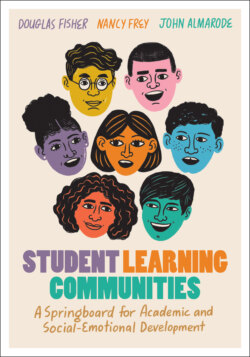Читать книгу Student Learning Communities - Нэнси Фрей - Страница 12
На сайте Литреса книга снята с продажи.
Tasks and Experiences That Encourage Student Dialogue
Оглавление. . . . . . . . . . . . . . . . . . . .
"The way to get a good idea is to get lots of ideas."
This insight is widely attributed to the Nobel Prize–winning chemist and peace activist Linus Pauling, the only man to have won a Nobel in two different fields. Pauling's achievement might have been singular, but his work was collaborative, hinging on the free exchange of ideas at his lab at Caltech as he and his colleagues worked out the problem of electronegativity and its relationship to ionic bonds between atoms.
You may not be running a quantum chemistry research lab, but, like Pauling, you are in the business of fostering the generation of ideas that lead to learning. Doing this successfully requires you to attend to the first necessary condition for establishing and sustaining a student learning community (SLC): providing well-designed experiences and tasks that incorporate and encourage student dialogue.
Recall from Chapter 1 the experience of mathematics teacher Grace Coates (2005), who naïvely believed that simply placing learners in a group would result in collective learning. She expected engaged conversation—high-quality, purposeful student talk; instead, she got awkward silence. Similarly, middle school history teacher Lisa Brooks planned a small-group discussion activity in which her students would explore the essential question "How did post–World War I Europe set the stage for World War II?" She reviewed a collection of curated resources with her students, then released them to formulate a group response and defense. And what happened next? "They just sat there in silence. No one talked. My class, which is very chatty on a daily basis, was simply sitting with a group of their peers looking awkwardly at each other."
Whether they are deployed in 7th grade U.S. history or high school algebra or a 2nd grade classroom, all collaborative learning tasks should be set up to give students opportunities to engage in academic discourse around targeted skills, knowledge, and understandings. These tasks should also provide students an opportunity to learn and practice social and emotional skills. Maybe the teacher's objective is to get learners to make inferences about international conflicts or analyze the use of the horizon line in various pieces of art. Maybe it's to explore the role of symbolism in a text, develop a mathematical model for a specific phenomenon, or design a water filtration system. In all cases, completing the task requires students to participate in critical dialogue around the ideas involved. We want them to engage like a collective of historians, art curators, literary critics, mathematicians, and scientists. We want them to be invigorated, to wrestle with ideas and concepts. We want them to communicate, treat their peers with respect, strive to understand one another's perspectives, develop healthy relationships, persevere through challenge, and develop a sense of self. Too often, though, what we get are surface-level conversations where the most probing question students ask one another is along the lines of "What page did you use to find that answer?"
Of course, no teacher strives to put poorly designed experiences and tasks in front of a group of students, but all of us have done so—and typically we only realize this when an activity that looked great in a lesson plan is a painful failure … when the questions and conversation prompts we provide are met with crickets instead of the engaged discourse of an SLC. When creating tasks and activities for collaborative learning in face-to-face and virtual learning environments, it's essential to remember how much language matters.
